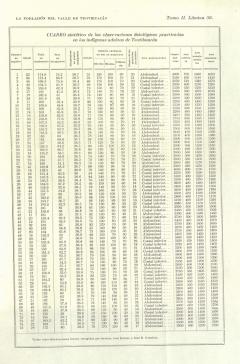The Mexican Revolution (1910) promoted a space for reflection on the status of the Mexican indian, which transformed him as the figure that would justify the political agendas and reshape the model people of the new nation. There was a redefinition process from the strongly influential characterization as sick criminals proper to the end of nineteenth-century Porfirian medico-legal anthropology to the civilized Indígena of the post-revolutionary Manuel Gamio’s integral anthropology. This project explored the different ways in which the Mexicans were conceptualized as biological populations and the consequent transformations of the anthropological approaches used to classify them during the first half of the twentieth century.
Integral Anthropology: One of the main objectives of this project was to reconstruct the kind of anthropology that was developed during the period of the Revolution and highlight the differences between physical anthropology and biotypology. This concern was in reaction to common views that consider, on the one hand, that these anthropological approaches are the same because of the use of typological analysis and, on the other, that all of them were in the same manner racist and discriminatory. Contrary to the last, the work of Gamio is located between some other similar and contemporary nationalistic works like the one of Edgard Roquette-Pinto in Brazil and Herbert John Fleure in Great Britain, who were opposed to the idea that the Indigenous, Mestizo, or Welsh people could be in some way primitive or inferior to other human races and promoted some kind of positive eugenics. The work of Gamio reconceptualises the indians exalting, not only their physiology and culture, but their psychology—outlining the conditions of possibility for an indian subjectivity as one of the main hallmarks. This perspective was possible through a particular understanding of psychology for anthropologists used to identify “degrees of civilization” between different cultures introduced by Franz Boas and expressed in the peculiar anthropology that Gamio called “integral.”
Cultural stratigraphy: Gamio, Roquete-Pinto, and Fleure shared the common interest for the psychological attributes within a specific environment as well as within some kind of holistic anthropology, which in the case of Brazil was conceptualized as racial temperament, in the case of Wales as moral topography and in the case of the Mexican population as cultural stratigraphy. Likewise, they moved their laboratories from the museum to the countryside and, instead of archiving the gathered data in cabinets, they created a fieldwork interacting with the data and the people in a practical way. The use of a psychological point of view gave a different meaning to this kind of anthropology and to the status of the indians since they were conceptualized as subjects able to revitalized the land. This last was opposed to studies developed by traditional physical anthropology in which the people were objectified as types to be collected and ordered in museums. The resultant is an image that delineates the rural population as a source of isolated pure qualities for the good of the model people of the nation in which race, geography, and psychology give sense to the land, thinking people as subjects capable to revive it.
Human Populations and Kinds of Anthropologies: Finally, this project investigated the different ways in which these “human populations” were characterized through these three disciplines empowered to define the model citizens during the first half of the twentieth century: physical anthropology, integral anthropology, and biotypology. The main objective of this comparison was to understand how the people were grouped together and conceptualized either as fixed types (objects in the museums) or dynamical populations (subjects on the land). Paying special attention, in this process, to the many manners in which a classification reflects its dependency to the historical and contextual factors as well as the practices involved, since all of this defines the interests that delimit the boundaries of the grouping in a given time with an explanatory aim giving to the class a use.

